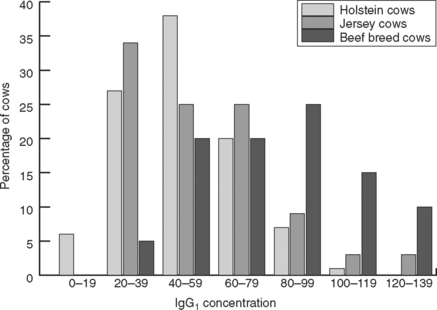CHAPTER 43 Principles of Colostrum Feeding
The prenatal transfer of immunoglobulins to the bovine fetus is limited by the syndesmochorial placental structure. Consequently, calves are essentially agammaglobulinemic at birth.1 This makes the ruminant neonate totally dependent on colostrum as an immunoglobulin source. Immunoglobulin G1 (IgG1) is the predominant isotype in bovine colostrum, but IgA and IgM isotypes also are present.2
Colostrogenesis is a distinct phase of mammary gland development that clearly is regulated in part by the lactogenic hormones estrogen and progesterone. In ruminants, this phase occurs during the last month of gestation and ceases abruptly just before parturition.3 During this period, circulating maternal IgG1 molecules diffuse across the vascular endothelium within the mammary gland and bind to specific IgG1 Fc receptors on the basolateral membrane of the mammary secretory epithelium. The molecules then enter the lacteal secretion by micropinocytic endocytosis.2 Premature induction of parturition has significant implications. Prostaglandins reduce IgG concentrations, whereas corticosteroids reduce the volume of colostrum produced.4, 5 Mammalian lacteal secretions also contain nonimmunologic factors such as maternal leukocytes, lactoperoxidase, and the iron-binding apoprotein lactoferrin. Lactoferrin binds the lipid A portion of endotoxin and also sequesters iron. It is both bactericidal and bacteriostatic and may be important in neonatal immunity in the face of gramnegative infections.6
Neonatal survival is dependent on an interaction among the host, its environment, and management influences. Calves with failure of passive transfer (FPT) have an increased risk of death; however, many calves with FPT will survive.7 Adequate passive transfer reduces the risk of morbidity and mortality during the first months of life. Improved productivity in feedlot animals and in dairy heifers during their first lactation also has been attributed to adequate passive immunity.1
FACTORS INFLUENCING PASSIVE TRANSFER
Age of the Dam
It often is advocated that the colostrum from first-calf heifers has a lower IgG concentration than that of older cows and should therefore be discarded and substituted with colostrum from older cows. Several recent studies, however, failed to demonstrate any differences between colostral IgG concentration from cows in their first and those in their second or later lactations. Third-lactation cows did produce colostrum with a higher IgG concentration.8, 9 A reasonable conclusion is that calves should be fed only colostrum obtained from third-lactation cows. Third-lactation cows generally constitute only about 30% of a dairy herd, however. Consequently, in order to provide colostrum for the total calf population, each third-lactation cow would have to produce sufficient colostrum for 3.33 calves. This is an unreasonable expectation. Additionally, the magnitude of the change in colostral IgG concentrations between the first and later lactations is relatively small.1, 8
Quality of the Colostrum
Differentiating high-immunoglobulin-concentration colostrum from low-immunoglobulin-concentration colostrum is problematic.1 Furthermore, colostrum immunoglobulin content is highly variable across cattle breeds. Some generalizations hold true, however. Beef breed cows, such as Angus and Hereford, generally have higher colostral immunoglobulin concentrations than those in dairy cows.2 Among the dairy breeds, Jersey and Guernsey cattle have higher colostral IgG concentrations than those in Holsteins2,4,8 (Fig. 43-1). Pritchett and colleagues evaluated the weight of colostrum at first milking as a measure of colostrum quality. This variable correlated most highly with colostral IgG1 concentration (r = −0.29). They observed that colostrum weighing less than 8.5 kg had a significantly higher IgG1 concentration (P = 0.0001). Although this trend was observed in cows of all ages, it was more pronounced in the second-lactation cows.9 In 1979, Fleenor and Stott proposed the use of hydrometry. This approach involved using the colostrometer to assess IgG1 concentration based on the relative density of the colostrum sample.10 Recently, however, Morin and co-workers observed that colostral specific gravity correlated more closely with colostral protein concentration (r2 = 0.76) than with colostral IgG1 concentration (r2 = 0.53).11
Stay updated, free articles. Join our Telegram channel

Full access? Get Clinical Tree



